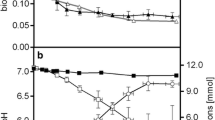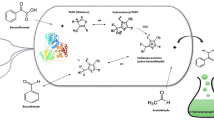Abstract
In an earlier study, biocatalytic carbon oxyfunctionalization with water serving as oxygen donor, e.g., the bioconversion of quinaldine to 4-hydroxyquinaldine, was successfully achieved using resting cells of recombinant Pseudomonas putida, containing the molybdenum-enzyme quinaldine 4-oxidase, in a two-liquid phase (2LP) system (Ütkür et al. J Ind Microbiol Biotechnol 38:1067–1077, 2011). In the study reported here, key parameters determining process performance were investigated and an efficient and easy method for product recovery was established. The performance of the whole-cell biocatalyst was shown not to be limited by the availability of the inducer benzoate (also serving as growth substrate) during the growth of recombinant P. putida cells. Furthermore, catalyst performance during 2LP biotransformations was not limited by the availability of glucose, the energy source to maintain metabolic activity in resting cells, and molecular oxygen, a possible final electron acceptor during quinaldine oxidation. The product and the organic solvent (1-dodecanol) were identified as the most critical factors affecting biocatalyst performance, to a large extent on the enzyme level (inhibition), whereas substrate effects were negligible. However, none of the 13 alternative solvents tested surpassed 1-dodecanol in terms of toxicity, substrate/product solubility, and partitioning. The use of supercritical carbon dioxide for phase separation and an easy and efficient liquid–liquid extraction step enabled 4-hydroxyquinaldine to be isolated at a purity of >99.9% with recoveries of 57 and 84%, respectively. This study constitutes the first proof of concept on an integrated process for the oxyfunctionalization of toxic substrates with a water-incorporating hydroxylase.





Similar content being viewed by others
References
Backeberg OG (1931) CCCXCI.—The constitution of the bases formed by the action of phosphoryl chloride on acetanilide and on phenacetin. J Chem Soc 2814–2817. doi:10.1039/JR9310002814
Bagdasarian M, Lurz R, Rückert B, Franklin FCH, Bagdasarian MM, Frey J, Timmis KN (1981) Specific purpose plasmid cloning vectors II. Broad host range, high copy number, RSF1010-derived vectors, and a host-vector system for gene cloning in Pseudomonas. Gene 16:237–247
Bang S, Choi W, Choi C, Cho M (1996) Production of cis, cis-muconic acid from benzoic acid via microbial transformation. Biotechnol Bioprocess Eng 1:36–40
Brandenbusch C, Bühler B, Hoffmann P, Sadowski G, Schmid A (2010) Efficient phase separation and product recovery in organic-aqueous bioprocessing using supercritical carbon dioxide. Biotechnol Bioeng 107:642–651
Bühler B, Bollhalder I, Hauer B, Witholt B, Schmid A (2003) Use of the two-liquid phase concept to exploit kinetically controlled multistep biocatalysis. Biotechnol Bioeng 81:683–694
Bühler B, Witholt B, Hauer B, Schmid A (2002) Characterization and application of xylene monooxygenase for multistep biocatalysis. Appl Environ Microbiol 68:560–568
Chen GQ, Wang HH, Li XT (2009) Production and characterization of homopolymer polyhydroxyheptanoate (P3HHp) by a fadBA knockout mutant Pseudomonas putida KTOY06 derived from P. putida KT2442. Process Biochem 44:106–111
Clarke KG, Williams PC, Smit MS, Harrison STL (2006) Enhancement and repression of the volumetric oxygen transfer coefficient through hydrocarbon addition and its influence on oxygen transfer rate in stirred tank bioreactors. Biochem Eng J 28:237–242
Comes JE, Beelman RB (2002) Addition of fumaric acid and sodium benzoate as an alternative method to achieve a 5-log reduction of Escherichia coli O157:H7 populations in apple cider. J Food Prot 65:476–483
Desai JD, Banat IM (1997) Microbial production of surfactants and their commercial potential. Microbiol Mol Biol Rev 61:47–64
Déziel E, Comeau Y, Villemur R (1999) Two-liquid-phase bioreactors for enhanced degradation of hydrophobic/toxic compounds. Biodegradation 10:219–233
Dumont E, Delmas H (2003) Mass transfer enhancement of gas absorption in oil-in-water systems: a review. Chem Eng Process 42:419–438
Edmondson DE, Ivanov NV, Hubalek F, Trani M (2003) Factors involved in the assembly of a functional molybdopyranopterin center in recombinant Comamonas acidovorans xanthine dehydrogenase. Eur J Biochem 270:4744–4754
Erickson LE, Nakahara T (1975) Growth in cultures with 2 liquid-phases: hydrocarbon uptake and transport. Process Biochem 10:9–13
Faber K (1997) Biotransformations in organic chemistry, 3rd edn. Springer, Berlin Heidelberg New York
Follonier S, Panke S, Zinn M (2012) A reduction in growth rate of Pseudomonas putida KT2442 counteracts productivity advances in medium-chain-length polyhydroxyalkanoate production from gluconate. Microb Cell Fact. doi:10.1186/1475-2859-10-25
Ho CS, Ju LK, Baddour RF (1990) Enhancing penicillin fermentations by increased oxygen solubility through the addition of normal-hexadecane. Biotechnol Bioeng 36:1110–1118
Ju LK, Lee JF, Armiger WB (1991) Enhancing oxygen transfer in bioreactors by perfluorocarbon emulsions. Biotechnol Progr 7:323–329
Julsing MK, Kuhn D, Schmid A, Bühler B (2012) Resting cells of recombinant E. coli show high epoxidation yields on energy source and high sensitivity to product inhibition. Biotechnol Bioeng. doi:10.1002/bit.24404
Leon R, Fernandes P, Pinheiro HM, Cabral JMS (1998) Whole-cell biocatalysis in organic media. Enzyme Microb Technol 23:483–500
Linek V, Benes P (1976) A study of the mechanism of gas absorption into oil-water emulsions. Chem Eng Sci 31:1037–1046
Lozano P (2010) Enzymes in neoteric solvents: from one-phase to multiphase systems. Green Chem 12:555–569
Lye GJ, Woodley JM (1999) Application of in situ product-removal techniques to biocatalytic processes. Trends Biotechnol 17:395–402
Neumann M, Schulte M, Junemann N, Stocklein W, Leimkuhler S (2006) Rhodobacter capsulatus XdhC is involved in molybdenum cofactor binding and insertion into xanthine dehydrogenase. J Biol Chem 281:15701–15708
Park SH, Ko YJ, Kini CK (2001) Toxic effects of catechol and 4-chlorobenzoate stresses on bacterial cells. J Microbiol 39:206–212
Parschat K, Hauer B, Kappl R, Kraft R, Huttermann J, Fetzner S (2003) Gene cluster of Arthrobacter ilicis Rü61a involved in the degradation of quinaldine to anthranilate. J Biol Chem 278:27483–27494
Reva ON, Weinel C, Weinel M, Bohm K, Stjepandic D, Hoheisel JD, Tummler B (2006) Functional genomics of stress response in Pseudomonas putida KT2440. J Bacteriol 188:4079–4092
Rols JL, Goma G (1991) Enhanced oxygen transfer rates in fermentation using soybean oil-in-water dispersions. Biotechnol Lett 13:7–12
Sambrook J, Fritsch EF, Maniatis T (1989) Molecular cloning: a laboratory manual, 2nd edn. Cold Spring Harbor Laboratory, Cold Spring Harbor
Schmid A, Kollmer A, Mathys RG, Witholt B (1998a) Developments toward large-scale bacterial bioprocesses in the presence of bulk amounts of organic solvents. Extremophiles 2:249–256
Schmid A, Kollmer A, Witholt B (1998b) Effects of biosurfactant and emulsification on two-liquid phase Pseudomonas oleovorans cultures and cell-free emulsions containing n-decane. Enzyme Microb Technol 22:487–493
Self WT (2002) Regulation of purine hydroxylase and xanthine dehydrogenase from Clostridium purinolyticum in response to purines, selenium, and molydenum. J Bacteriol 184:2039–2044
Sikkema J, Debont JAM, Poolman B (1995) Mechanisms of membrane toxicity of hydrocarbons. Microbiol Rev 59:201–222
Tang WL, Zhao H (2009) Industrial biotechnology: tools and applications. Biotechnol J 4:1725–1739
Toyomasu T, Takiue T, Ikeda N, Aratono M (1998) Dihedral angle of lens and interfacial tension of air long chain alcohol water systems. Part 2. Langmuir 14:7313–7320
Tucker JGF, Irvin JL (1951) Apparent ionization exponents of 4-hydroxyquinoline, 4-methoxyquinoline and n-methyl-4-quinolone; evaluation of lactam–lactim tautomerism. J Am Chem Soc 73:1923–1929
Ütkür FÖ, Gaykawad S, Bühler B, Schmid A (2011) Regioselective aromatic hydroxylation of quinaldine by water using quinaldine 4-oxidase in recombinant Pseudomonas putida. J Ind Microbiol Biotechnol 38:1067–1077
van Sonsbeek HM, Beeftink HH, Tramper J (1993) 2-Liquid-phase bioreactors. Enzyme Microb Technol 15:722–729
Villers D, Platten JK (1988) Temperature-dependence of the interfacial tension between water and long-chain alcohols. J Phys Chem 92:4023–4024
Westgate S, Bell G, Halling PJ (1995) Kinetics of uptake of organic liquid substrates by microbial cells: a method to distinguish interfacial contact and mass transfer mechanisms. Biotechnol Lett 17:1013–1018
Woodley JM (2006) Choice of biocatalyst form for scalable processes. Biochem Soc Trans 34:301–303
Woodley JM, Bisschops M, Straathof AJJ, Ottens M (2008) Future directions for in situ product removal (ISPR). J Chem Technol Biotechnol 83:121–123
Woodley JM, Lilly MD (1990) Extractive biocatalysis: the use of 2-liquid phase biocatalytic reactors to assist product recovery. Chem Eng Sci 45:2391–2396
Acknowledgments
We gratefully acknowledge Prof. Fetzner for providing P. putida KT2440 (pKP1) cells. This project was supported by the International Max Planck Research School (IMPRS-CB), the European Union (EFRE), and the Ministry of Innovation, Science, Research and Technology of North Rhine-Westphalia (Bio.NRW, Technology Platform Biocatalysis, RedoxCell).
Author information
Authors and Affiliations
Corresponding author
Rights and permissions
About this article
Cite this article
Ütkür, F.Ö., Thanh Tran, T., Collins, J. et al. Integrated organic–aqueous biocatalysis and product recovery for quinaldine hydroxylation catalyzed by living recombinant Pseudomonas putida . J Ind Microbiol Biotechnol 39, 1049–1059 (2012). https://doi.org/10.1007/s10295-012-1106-0
Received:
Accepted:
Published:
Issue Date:
DOI: https://doi.org/10.1007/s10295-012-1106-0




